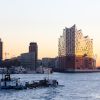Urban development
Successful conversion projects are now defining the “new” faces of many Germany cities.

Looking back over the years since the fall of the Wall, the 1990s were like a second Gründerzeit, the period of rapid change in 19th-century Germany that was also reflected in new trends in the arts and architecture. Following reunification, the theatre and the fine arts suddenly seemed intoxicated on creativity, and although democracy and Europe had to be re-learnt, urban planners and architects in particular were confronted with conditions about which they could only have dreamt during the years of complacency that had gone before. The end of the Cold War did not only create enormous empty innercity spaces along the Wall in Berlin, but also encouraged planners to undertake visionary urban development projects throughout the country.
The buzzword of this urban planning renaissance was “conversion”. After reunification, professionals in this sector were energised by the opportunity to transform the large spaces that had previously been used for military, transport or industrial purposes. These cordoned-off areas had been like forbidden cities within the city, fragmenting and dividing the whole. The new model of the integrated and dynamic city without artificial boundaries was applied to realise grand solutions. The trains were to run underground in Stuttgart, Munich and Frankfurt to enable the building of new mixed quarters on former railway sites. Hamburg, Duisburg, Düsseldorf, Cologne and Bremen planned large port redevelopments on old wharfs. And depending on their size, abandoned industrial sites were converted into cultural centres, apartment blocks or entire new districts.
Like any gold rush, however, the drive for conversion often led to disenchantment. In many places, the German culture of compromise had difficulty with these aggressive megaprojects when they paid too little regard to the concerns of local people. The impassioned argument about the Stuttgart 21 development project on the site of the city’s central station was the sign of a certain societal apprehension that reached far beyond that particular case. Although a majority eventually confirmed the project in a referendum, many people clearly saw the rapid reconstruction of the city centre as the destruction of their home town. Nevertheless, onerous conflicts of this kind have not put a stop to the sensible trend towards inner concentration: 25 years after the fall of the Wall, Germany is a paradise for urban reconstruction. In order to gain precious city-centre redevelopment sites, stations are being moved – as in Hamburg-Altona, for example – or even an airport is being relocated – as in Berlin. A new city district with an artificial lake is being created in Dortmund on the site of the former Phoenix steelworks, a complex that had a 150-year industrial past. The extremely high costs eventually meant that moving rail traffic underground was only agreed in Stuttgart, but Frankfurt and Munich – and various other cities too – have relocated rail freight to the periphery and replaced freight yards with new urban districts that were surprisingly often named Europaviertel (European Quarter).
The creation of new urban centres of gravity was also meant to stop the exodus from cities that has led to the growth of urban sprawl since the 1960s. This movement has been slowly reversed by attractive city-centre housing, the closeness of workplaces and homes as well as the high concentration of educational, cultural and commercial amenities that many conversion projects promised. Semi-detached houses “in leafy suburbs” have lost their appeal for young families, and many bored residents of suburban cul-de-sacs have moved back into town.
After most of the conversion projects of the post-reunification decade were completed or at least major parts of them realised, a fundamental debate arose among experts and interested citizens about the right path for the future. Is modern urban development with its often large uniform blocks really a meaningful complement to an existing city? Has contemporary architecture created soulless districts by not taking into account local symbols of identification? Do we need a new urban development model?
There is intense debate about these new city districts in letters to the editor, architectural manifestos and local referendums. And in some especially controversial locations the architectural transformation has eventually become a conversion into nothing. Despite the great demand for housing in Berlin, the result of the recent referendum about the future of its former city airport in Tempelhof means that the airfield cannot be built on at all. The former military airfield is now to be used as a public park. The third major period of urban renewal after the end of the 19th century and the immediate post-war era has therefore also seen a renewal of the culture of debate. Ordinary citizens are well-informed and want to be heard and contribute. Accordingly, a number of municipalities have organised international architectural exhibitions to develop new open planning formats to ensure that not only developers decide what happens in their city. The conversion of disused industrial sites is therefore also leading to the conversion of the industry. Now, 25 years after the fall of the Wall, when it comes to urban planning, civil society can also claim: We are the people! ▪

